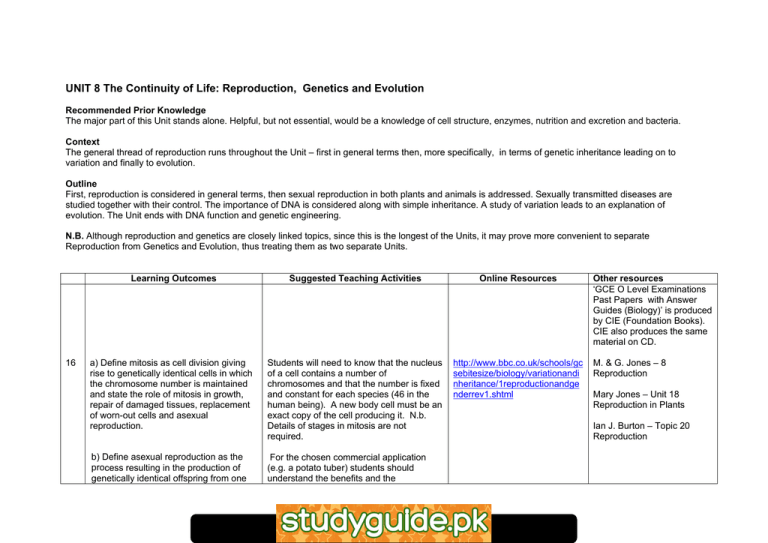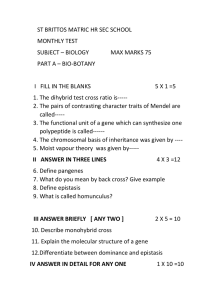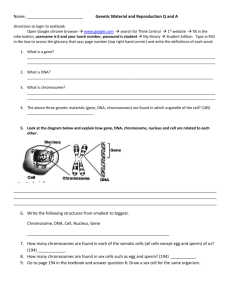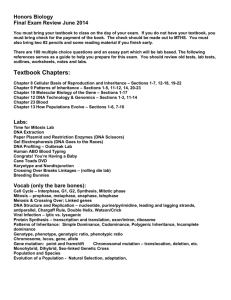UNIT 8
advertisement

UNIT 8 The Continuity of Life: Reproduction, Genetics and Evolution Recommended Prior Knowledge The major part of this Unit stands alone. Helpful, but not essential, would be a knowledge of cell structure, enzymes, nutrition and excretion and bacteria. Context The general thread of reproduction runs throughout the Unit – first in general terms then, more specifically, in terms of genetic inheritance leading on to variation and finally to evolution. Outline First, reproduction is considered in general terms, then sexual reproduction in both plants and animals is addressed. Sexually transmitted diseases are studied together with their control. The importance of DNA is considered along with simple inheritance. A study of variation leads to an explanation of evolution. The Unit ends with DNA function and genetic engineering. N.B. Although reproduction and genetics are closely linked topics, since this is the longest of the Units, it may prove more convenient to separate Reproduction from Genetics and Evolution, thus treating them as two separate Units. 16 Learning Outcomes Suggested Teaching Activities Online Resources a) Define mitosis as cell division giving rise to genetically identical cells in which the chromosome number is maintained and state the role of mitosis in growth, repair of damaged tissues, replacement of worn-out cells and asexual reproduction. Students will need to know that the nucleus of a cell contains a number of chromosomes and that the number is fixed and constant for each species (46 in the human being). A new body cell must be an exact copy of the cell producing it. N.b. Details of stages in mitosis are not required. http://www.bbc.co.uk/schools/gc sebitesize/biology/variationandi nheritance/1reproductionandge nderrev1.shtml b) Define asexual reproduction as the process resulting in the production of genetically identical offspring from one For the chosen commercial application (e.g. a potato tuber) students should understand the benefits and the www.xtremepapers.net Other resources ‘GCE O Level Examinations Past Papers with Answer Guides (Biology)’ is produced by CIE (Foundation Books). CIE also produces the same material on CD. M. & G. Jones – 8 Reproduction Mary Jones – Unit 18 Reproduction in Plants Ian J. Burton – Topic 20 Reproduction parent and describe one named, commercially important application of asexual reproduction in plants. disadvantages of this method of reproduction. c) State that gametes are the result of a reduction division in which the chromosome number is halved from diploid to haploid. Details of meiotic division are not required other than its halving of the chromosome number. The terms gamete, diploid and haploid should be explained. d) Define sexual reproduction as the process involving the fusion of haploid nuclei to form a diploid zygote and the production of genetically dissimilar offspring. Learning Activity Students should appreciate that each parent therefore makes an equal contribution to the diploid cell from which an offspring will develop. e) Identify and draw, using a hand lens if necessary, the sepals, petals, stamens and carpels of one, locally available, named, insect-pollinated, dicotyledonous flower, and examine the pollen grains under a light microscope. If possible, a large, brightly-coloured, scented flower with visible nectar should be chosen. Ensure that students produce large drawings, with a sharp HB pencil, draw clean lines and give the magnification of their drawing (e.g. x3). Learning Outcome f) State the functions of the sepals, petals, anthers and carpels. Learning Activity g) Use a hand lens to identify and describe the anthers and stigmas of one, locally available, named, wind-pollinated flower, and examine the pollen grains under a light microscope. Learning Outcomes It will be necessary to explain that carpels are made up of component parts – stigma, style, ovary and ovules. Also ensure that students are clear that pollen (grains) are not gametes but that they contain the gametes. Note that a drawing is not required, but it would be valuable for students to list any noticeable differences from the features seen in the insect-pollinated flower. www.xtremepapers.net ‘Teaching and Assessing Practical Skills in Science’ Dave Hayward (CUP) pages 43,44 h) Outline the process of pollination and distinguish between self-pollination and cross-pollination. Learning Activity i) Compare, using fresh specimens, an insect-pollinated and a wind-pollinated flower. Learning Outcome j) Describe the growth of the pollen tube and its entry into the ovule followed by fertilisation (production of endosperm and details of development are not required). Learning Activity k) Investigate and describe the structure of a non-endospermic seed in terms of the embryo (radicle, plumule and cotyledons) and testa, protected by the pericarp (fruit wall). Learning Outcomes l) State that seed and fruit dispersal by wind and animals provides a means of colonising new areas. Learning Activity Supply students with an example of a wind- and of an animal-dispersed fruit or Continuing the theme in c) and d) above, the implications of self-pollination can be discussed. Students should be invited to produce a list of noticeable differences, but a definitive table should then be provided for reference. An OHP transparency will offer the chance to show the path taken by the pollen tube and can be suitably labelled. On an unlabelled version of the diagram, students may then add the relevant detail. Pea or large bean seeds are suitable, soaked for 24 hours before use. This investigation offers students the opportunity for further drawing practice and, if time permits, the chance to revise food tests on substances stored in the cotyledons. Students may be asked to suggest advantages of the ability to colonise new areas. http://www.zephyrus.co.uk/seed dispersal.html Stress that fruit and seed dispersal by wind or animals can happen only after pollination (by wind or insects) and the two very different processes must not be confused. http://waynesword.palomar.edu/ plfeb99.htm (many wind examples) www.xtremepapers.net seed. Instruct students to construct a table of differences between the two and suggest reasons for the features they observe. Ideally they should be those considered in m) below. Although there are adaptations for different methods of animal dispersal, only one need be considered in detail. Learning Outcomes m) Describe the external features of one, locally available, named example of a wind-dispersed fruit or seed and one named example of an animal-dispersed fruit or seed Note that ‘warmth’ is scientifically vague and that seeds surrounded by ‘moisture’ do not germinate –atmospheric air contains moisture. n) Investigate and state the environmental conditions that affect germination of seeds: suitable temperature, water and oxygen. For reasons of safety and expense, the pyrogallol container might take the form of one demonstration experiment set up by the teacher. This activity reinforces the need for a control in experimental work. http://www.tomatosphere.org/E ngManual/start9.html Learning Activity Containers of seeds should be set up, one lacking only a suitable temperature (placed in ‘fridge at c. 4 oC), one lacking only water and one lacking only oxygen (sealed and containing alkaline pyrogallol). Also a control, with seeds exposed to all three conditions. Learning Outcomes o) Describe the uses of enzymes in the germination of seeds. This section echoes the work on enzymes in Unit 3, 5 o) and links also to the work on enzymes in Unit 1, 3. The need to convert insoluble storage compounds into soluble ones that can be transported should be stressed. The remainder of this unit may generate important, wider discussion which the teacher should be prepared to answer both honestly and sensitively. Ian J. Burton – Topic 21 Sexual Reproduction in Human Beings http://www.emc.maricopa.edu/f aculty/farabee/BIOBK/BioBook REPROD.html www.xtremepapers.net Mary Jones – Unit 19 Reproduction in Humans p) Identify on diagrams of the male reproductive system and give the functions of the testes, scrotum, sperm ducts, prostate gland, urethra and penis. q) Identify on diagrams of the female reproductive system and give the functions of the ovaries, oviducts, uterus, cervix and vagina. r) Compare male and female gametes in terms of size, numbers and mobility. s) Describe the menstrual cycle, with reference to the alternation of menstruation and ovulation, the natural variation in its length and the fertile and infertile phases of the cycle. t) Describe fertilisation and early development of the zygote simply in terms of the formation of a ball of cells that becomes implanted in the wall of the uterus. u) State the function of the amniotic sac and amniotic fluid. v) Describe the function of the placenta and umbilical cord in relation to exchange of dissolved nutrients, gases and excretory products (no structural details are required). w) Describe the special dietary needs of p) and q) are outcomes that lend themselves to the use of labelled OHP transparencies for descriptive purposes followed by an unlabelled versions of the diagrams for students to label. Comparisons should be supported by reasons for the differences. Annotated diagrams showing the cycle divided into days and showing the build-up and breakdown of the uterus lining are helpful. The location of fertilisation should be clearly described. Division of the zygote by mitosis prior to implantation should be mentioned. Ways in which the embryo is protected by the fluid (contained by the sac) should be discussed. Links here with Unit 1,2 a), Unit 3, 5 a) c) n) and s), Unit 4, 7 j) k) and Unit 5, 9 a) b) and c). Stress that maternal and fetal bloods do not mix. The appropriate reason for each additional dietary requirement should be mentioned. As well as the benefits of breast milk, deficiencies of bottle milk should be mentioned. http://www.clearblue.info/uk/Ge nericYourPeriods.cfm menstrual cycle – details (animation) and issues http://health.howstuffworks.com /adam-200127.htm amniotic fluid animation http://health.howstuffworks.com /adam-200018.htm pregnancy animation http://www.iowaclinic.com/wom ens/pregnancy/ipc/content/labor _delivery/tools/vaginal_anim.ht m vaginal delivery animation http://www.cyberparent.com/bfe ed2/index.html#Benefits (benefits of breast feeding) www.xtremepapers.net pregnant women. x) Describe the advantages of breast milk compared with bottle milk. 17 Family planning clinics are often helpful in supplying information and exhibits. y) Describe the following methods of birth control: natural, chemical (spermicides), mechanical, hormonal and surgical. The potentially severe nature of syphilis should be mentioned, also that concern about AIDS has diverted attention away from other STDs. The need for early treatment should be stressed. z) Explain that syphilis is caused by a bacterium that is transmitted during sexual intercourse. aa) Describe the symptoms, signs, effects and treatment of syphilis. Ensure that students are clearly aware that no cure is yet available, but, with care, its spread can be restricted. b) Discuss the spread of human immunodeficiency virus (HIV) and methods by which it may be controlled. a) Describe the difference between continuous and discontinuous variation and give examples of each. Learning activity Students can draw graphs to show the distribution of height or weight within the class. It might be insensitive, however, to use these examples if there is a class member who is particularly tall, short, fat or thin. The variation in length of forearm from elbow to fingertip might then be a more thoughtful alternative. http://herpescoldsores.com/std/syphilis.htm Ian J. Burton – Topic 22 Inheritance M. & G. Jones – 12 Inheritance and evolution Body weight and height are standard examples of continuous variation, and blood groups or sex of discontinuous variation. Graphs should be drawn of the distributions shown by the two types of variation. Mary Jones – Unit 20 Inheritance http://www.johnkyrk.com/chrom osomestructure.html www.xtremepapers.net Learning Outcomes b) State that a chromosome includes a long molecule of DNA. Detail of DNA structure is not required, but later explanation becomes easier if it is described as two long strands cross-linked by a succession of paired molecules called bases. c) State that DNA is divided into sections called genes. Thus each gene comprises its own particular sequence of linked bases. d) Explain that genes may be copied and passed on to the next generation. When a cell divides, its nucleus first makes an exact copy of each strand of DNA (and, therefore, also of each gene). The original passes into the nucleus of one cell, and its copy passes into the other. In this way, the same genes are passed from generation to generation. e) Define a gene as a unit of inheritance and distinguish clearly between the terms gene and allele. f) Describe complete dominance using the terms dominant, recessive, phenotype and genotype. g) Describe mutation as a change in the structure of a gene (sickle cell anaemia) or in the chromosome number (47 in Down’s syndrome instead of 46). http://www.bbc.co.uk/schools/gc sebitesize/biology/variationandi nheritance/0dnaandgenesrev5. shtml (also, rev6.shtml & rev7.shtml) Each gene represents one piece of information – instructions for a certain characteristic - passed from parent to offspring. Alleles are different varieties of the same gene. These terms follow naturally from a consideration of genes and alleles above. It may be illustrated within the class by the gene for tongue rolling, though a true understanding of genotype is unlikely to be gained until i) below. Though genes are handed on from generation to generation, they are subject to change, causing a change in phenotype. Most changes are very small and barely noticeable, others have a more marked effect. Change can also occur in www.xtremepapers.net chromosome number. h) Name radiation and chemicals as factors that may increase the rate of mutation. i) Predict the results of simple crosses with expected ratios of 3:1 and 1:1, using the terms homozygous, heterozygous, F1 generation and F2 generation. j) Explain why observed ratios often differ from expected ratios, especially when there are small numbers of progeny. k) Explain codominance by reference to the inheritance of the ABO blood phenotypes (A, B, AB, O, gene alleles IA, IB and Io). l) Describe the determination of sex in humans (XX and XY chromosomes). m) Describe variation and state that competition leads to differential survival of organisms, and reproduction by those organisms best fitted to the environment. Mutagens can have the effect of altering the molecular structure of a gene and thus altering the way in which the gene works. Students should be encouraged to draw full genetic diagrams to show these crosses. The diagrams should be annotated and include reference to parents and gametes. It should be stressed that the ratios are statistical and are those obtained only from large samples. Such diagrams demonstrate the same phenotype may have different genotypes. http://www.purchon.com/biology /abo.htm (but use the upper-case allele superscripts specified in the syllabus) Students will observe that there can be more than two alleles of the same gene. It will be necessary to point out the sex inheritance is the result of the inheritance of chromosomes, not of genes. The point needs to be made that variation is a random process which happens to leave some members at a survival advantage over other organisms in a particular environment. It does not occur ‘in order to adapt to the environment’ as students often believe. Organisms that survive then reproduce and hand on the advantage to at least some of their offspring. http://evolution.berkeley.edu/ev osite/evo101/IIIENaturalSelectio n.shtml http://encyclopedia.lockergnom e.com/s/b/Artificial_selection http://www.bbc.co.uk/schools/gc www.xtremepapers.net n) Assess the importance of natural selection as a possible mechanism for evolution. Survival of the better-adapted organisms, each themselves showing variations, some of which are advantageous, generation after generation, leads to evolutionary change in the species. o) Describe the role of artificial selection in the production of economically important plants and animals. When humans select organisms with characteristics that are commercially desirable and breed from them, variation can again enhance the selected characteristic – especially over many generations. p) Explain that DNA controls the production of proteins. q) State that each gene controls the production of one protein. The linking of amino acids to form a protein in the cells of a body is determined by DNA. The exact amino acids and their particular sequence in each different protein are controlled by one specific gene. r) Explain that genes may be transferred between cells (reference should be made to transfer between organisms of the same or different species). Human-to-human transfers in the case of treatment for cystic fibrosis may be explained as well as human to bacterium and from (disease-resistant) plant species to (non-resistant) plant species. The insulin gene can be identified and, with the aid of enzymes, isolated from the strand of DNA in the nucleus of a cell from a healthy person. Enzymes are again used to attach it to the DNA of a bacterium. Culture and extraction should be explained on lines similar to Unit 7, 14 e). s) Explain that the gene that controls the production of human insulin can be exerted into bacterial DNA. t) Understand that such genetically engineered bacteria can be used to produce human insulin on a commercial scale. u) Discuss potential advantages and dangers of genetic engineering. sebitesize/biology/variationandi nheritance/0dnaandgenesrev4. shtml http://www.accessexcellence.or g/RC/VL/GG/ then click on link to Gene Transfer in Insulin Production (under Biological Engineering) http://www.abpischools.org.uk/r esources/posterseries/geneng/advndis.asp (advantages and disadvantages) Students may have strong ethical as well as scientific views on this topic, but the teacher should ensure that a balanced consideration prevails. www.xtremepapers.net






